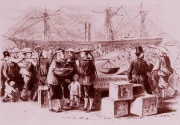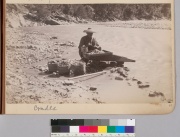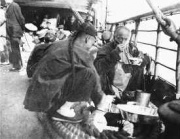The First Wave
From The Peopling of NYC
The First Chinese (1850s-1882)
The first documented Chinese immigrants came to the United States at the turn of the 19th century. For the most part, they were wealthy merchants and skilled craftsmen. However, Chinese immigration on a large scale did not begin until the mid-1800s. Fueled by news of the California Gold Rush, thousands of Chinese, mostly unskilled laborers and peasants, came to America eager to pursue the opportunities that America had to offer. They came in search of the “Gold Mountain of California”, hoping to get rich and send money back to their poor rural villages or to actually return back to China with their newly earned fortunes. Most of these immigrants were men. As a matter of fact, the male female ratio was approximately 19:1.
At first, this new wave of immigrants to the United States was accepted by the public, as well as the government. As they settled in the San Francisco area, they distinguished themselves by their hard working habits and unique farming techniques. By 1851, there were 25,000 Chinese immigrants working around the Gold Rush and San Francisco area. More then half of the Chinese population of the United States lived in this region. Eventually, they formed “large cities” of ethnic enclave where Chinese Americans lived, worked, shopped, and socialized. These cities are called Chinatowns. In the 1800’s these Chinatowns were extremely overcrowded, incredibly polluted, and infested with crime and drugs. By the mid 20th century, however, they were transformed into “quiet colorful tourist attractions”.
After many Chinese immigrants failed to strike fortunes in the Gold Rush, they turned to America’s rapidly expanding industries. Many found low paying jobs working in wool mills, shoe factories, or garment factories. They often took on jobs that no one else wanted, shunned by Americans as “dirty jobs”. In 1860, 10,000 Chinese immigrants got involved in building the western leg of the Central Pacific Railroad. Their salary was $35 a month, but considering that the cost of food was approximately $15 to $18 a month and since the railroad provided shelter for its workers, many men were about to put away about $20 a month.
Hostility against Chinese immigrants increased. Fear, ignorance, and post Civil War depression combined to create a hostile attitude towards them. They were blamed for occupying too many jobs within the cities. Ridiculed and called names like “rice-eaters," resentment towards Chinese immigrants grew. In 1862, 88 Chinese men were reported murdered, and hundreds of others were involved in “gang related attacks”. As the hostility increased, Chinese immigrants were not even safe at their jobs.
In 1870, the United States government passed the Naturalization Act, which for the first time in American history, barred free Chinese immigration, restricting immigration to only “white persons and persons of African descent”. Still, by 1880, Chinese immigrants made up more then 25% of California’s workforce and approximately 30,000 of them worked outside of California.
To “freeze the Chinese population”, in 1882 the US government passed the Chinese Exclusion Act. Its main purpose was to prevent excess to cheap labor. In 1890, at its peak, there were 107,488 Chinese immigrants in the US. Nonetheless, in the following decades, the Chinese population steadily declined. As the ratio of males to females in the country worsened (27:1 in 1890) and immigration was prohibited, the Chinese population in America plummeted.
Sources
- Journey to America
- History of Chinese Immigration
- A Brief History of Chinese Immigration to America
- Chinese Immigration and the Chinese in the United States


